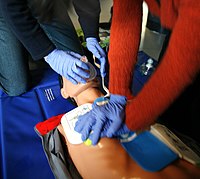
Photo from wikipedia
To the Editor: The survival rate from conventional cardiopulmonary resuscitation (CCPR) of out-of-hospital and in-hospital cardiac arrest ranges from 9% to 20%. Without returning of spontaneous circulation (ROSC) after CCPR,… Click to show full abstract
To the Editor: The survival rate from conventional cardiopulmonary resuscitation (CCPR) of out-of-hospital and in-hospital cardiac arrest ranges from 9% to 20%. Without returning of spontaneous circulation (ROSC) after CCPR, the chance of recovery is very poor. Initiating venoarterial extracorporeal membrane oxygenation in those patients may provide adequate organ perfusion that allows for longer organ viability and permit time for therapies seeking to correct the inciting pathologic event, which is termed extracorporeal cardiopulmonary resuscitation (ECPR). Time to treatment, ECPR-related complications, as well as etiology, have been recognized as themain predictors of survival for ECPR patients. ECPR has been carried out more and more in China, but the information on ECPR application remains unknown. Therefore, we conducted a retrospective survey about the usage of ECPR in China, including patient selection, initiation and management of extracorporeal mechanical ventilation (ECMO), patient outcome, and compared the status during 2017 and 2020.
Journal Title: Chinese Medical Journal
Year Published: 2022
Link to full text (if available)
Share on Social Media: Sign Up to like & get
recommendations!